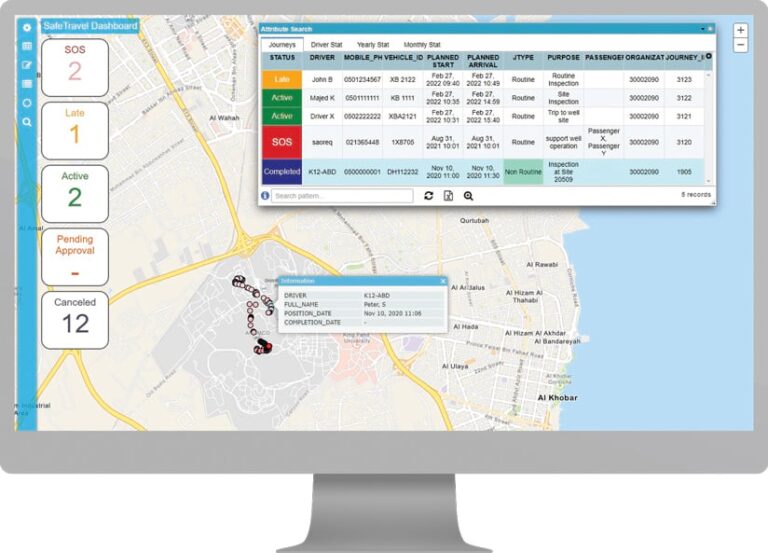At Saudi Arabian oil company Saudi Aramco, employees and contractors engaging in work-related vehicle travel must manage their trips using a journey management (JM) process that makes it easier to reduce travel-related risks. In the company’s day-to-day operations, which occur around the clock and span the Kingdom of Saudi Arabia, vehicle transportation is one of the activities with the highest potential risk. It isn’t unusual for drivers to get lost or stranded in desert areas, where most of the company’s oil exploration and drilling activities are carried out. In 2019, Saudi Aramco’s company vehicles racked up more than 200 million kilometers (124 million miles) in work-related travel throughout Saudi Arabia.
To minimize the increased hazards associated with traveling through remote desert areas, Saudi Aramco implemented its JM process based on the following core elements of its travel policy:
- Employees must inform their supervisors of where they are traveling to.
- Employees must reserve a vehicle that can handle the terrain and any hazards they may face.
- Employees must stay with their vehicle if they get lost or the vehicle breaks down or gets stuck in the sand.
- Supervisors must call 911 if their employees are out of contact for three or more hours.
In the past, all these processes were manual, and some were even paper based. But in alignment with ongoing digital transformation initiatives at Saudi Aramco, the GIS team developed an in-house, end-to-end, GIS-based solution called SafeTravel that is now available to employees and contractors online and on the go. ArcGIS Enterprise, ArcGIS Pro, and other ArcGIS apps and technology were key to imbuing the solution with sophisticated location intelligence.

An End-to-End Solution
SafeTravel is an easy-to-use GIS solution that consists of three main components: a mobile app, a web-based dashboard, and a back-end monitoring engine. It integrates Saudi Aramco’s existing ArcGIS Enterprise deployment with corporate automatic vehicle location (AVL) devices, a corporate emergency responder tool, a text messaging and email gateway, human resources services, and an enterprise resource planning (ERP) back end.
To set up the framework for the solution, the team used a mobile data collection app that is now part of ArcGIS Field Maps to gather data about remote areas and sites where Saudi Aramco employees and contractors travel for daily operations. The team also employed the app to record locations where there is no mobile network coverage.
With that data stored in ArcGIS Enterprise, the team created a custom mobile app and dashboard using ArcGIS API for JavaScript and other developer technology. To ensure that the maps in the solution display quickly and smoothly on desktop and mobile devices, the team published a new basemap layer service for mobile apps using caching tools in ArcGIS Pro.
When employees and contractors need to take a work trip in a company vehicle, they now start the travel process by creating a new trip in the SafeTravel mobile app. Based on the type of trip they are taking, the solution triggers an approval workflow that goes to the driver’s immediate supervisor and the department’s JM coordinator. Once a trip is approved, employees and contractors use the mobile app to pick an appropriate vehicle from a pool of AVL-equipped company cars. They then acknowledge a pretrip checklist.
When the trip actually begins, drivers depend on ArcGIS Navigator to find their way to remote Saudi Aramco sites. They can use the app to update their arrival time and report any emergencies during the trip. If all goes as planned, drivers can simply complete and close their trip in the app when they are finished. However, if they experience an emergency, they can tap the 911 button in the SafeTravel app to make an emergency phone call or use the SOS Panic button that is available in all Saudi Aramco corporate vehicles. Either way, the system sends a notification to the employee’s supervisors and JM coordinators and to the nearest 911 emergency control center.
Constant, Digital Communication
In the past, since the JM process was mandatory, each department at Saudi Aramco implemented its own JM solution that ranged from paper forms and Microsoft Excel files to simple apps. JM coordinators used to spend a lot of time making phone calls to drivers and entering updates manually into their records.
By shifting the entire JM process to a digital, ArcGIS technology-based format, trip records are now accurate; up-to-date; and stored in a single, unified, electronic system. SafeTravel also provides supervisors and JM coordinators with real-time visualizations of all active journeys and sends automatic notifications when someone’s trip doesn’t go as planned.
In addition, the system monitors all the company vehicles being used for travel and notifies management if any vehicles are on the road without an approved journey in SafeTravel. This ensures that employees and contractors don’t travel to remote areas without having done the proper preparation and gotten approval.
A major advantage of using SafeTravel is the system’s ability to maintain constant communication among drivers and JM coordinators. Once drivers begin a trip, their route is immediately uploaded to the SafeTravel dashboard, which has real-time tracking. If a driver is unable to reach his or her destination within an hour of the planned arrival time, the system alerts the driver’s direct manager and the JM coordinator for that department. If the delay extends to two hours, the system escalates the alert to the head of the driver’s division. If the driver doesn’t get in touch within three hours, the system automatically classifies the trip as an emergency and notifies the 911 center nearest to the driver’s last-known location, which is based on positioning data from the driver’s mobile device or satellite data from the vehicle’s AVL system. Thus, emergency responders can start search and rescue operations immediately.
GIS Is a Prerequisite
Not only does Saudi Aramco’s new SafeTravel system streamline and digitize all company travel, but it also has the potential to save lives. With employees and contractors driving through harsh desert conditions, to and from remote places, at all hours of the day and night, a GIS-based travel system is a prerequisite for Saudi Aramco—and the company now has that.




